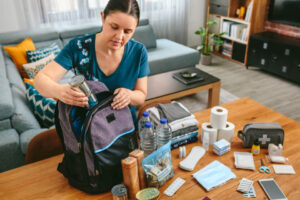
During a crisis, you have a lot to focus on. You need meals, communication with loved ones, safe drinking water, and so much more. But what about hygiene? How important are emergency hygiene measures? What hygiene items should you include in your emergency kit? Read on to find out.
Why You Need Survival Sanitation and Hygiene
Germs don’t take a break during a crisis. In fact, there may be even more bacteria and toxins than usual circulating in an emergency. Floodwaters can carry contaminants. Bodily injuries can make anyone more susceptible to infection. Unwashed hands when prepping or eating survival food can spread germs quickly.
Getting sick in the middle of a crisis will only add more stress. Fortunately, keeping up with personal hygiene can help prevent the spread of diseases and germs not only in your family but in your community, too.
Here are a few personal hygiene things to focus on in a crisis:
- Washing your hands with soap
- Brushing your teeth
- Bathing and washing your hair
All of these things require a clean water source. You should already have sealed water safe for drinking in your emergency kit. But in case your supply runs out, it’s a good idea to have a water purifier in your kit.
Purpose of Hygiene Kit and How to Create One
Appearances may not matter during a crisis, but that doesn’t mean you shouldn’t care for yourself. Make sure you can maintain basic hygiene. Emergency kits should include a supply of hygiene and sanitation items. Here are a few personal hygiene products to include:
- Bar soap
- Shampoo
- Hand sanitizer
- Toothpaste and a clean toothbrush
- Hairbrush or comb
Other hygiene items you may want to include are nail clippers and a washcloth or small towel. To keep germs at bay while using your cell phone, consider using a portable UV sanitizer and charger. Or, include sealed disinfectant wipes or disinfecting spray and a cloth in your emergency kit for your phone and other surfaces you might need to touch.
Emergency Hygiene and First Aid
Even with detailed attention to hygiene, things happen. People get sick. Accidents leave open wounds. Be sure you’re prepared by adding first aid and wellness items to your emergency kit.
Some items you already have in your hygiene kit work well for open wound first aid, such as antibiotic ointment. Can hand sanitizer clean wounds? No. Soap and water are best. Keep basic wound dressing supplies in your first aid kit to prevent the spread of disease from open wounds. Be sure to change dressings often to prevent bacteria and infections.
Basic medications such as painkillers, antacids, and digestive aids are a good idea to have in your kit, too. Add aloe vera gel and other topical creams to help keep your skin healthy, too.
Prepare Your Disaster Sanitation and Hygiene Kit Today
Planning for proper hygiene is only one piece of emergency preparedness. For survival food, gear, and more, turn to 4Patriots. We’re here to help with solar cookers for boiling water, nutritious survival meals, and anything else you need. Get your emergency kit ready today with help from 4Patriots.

